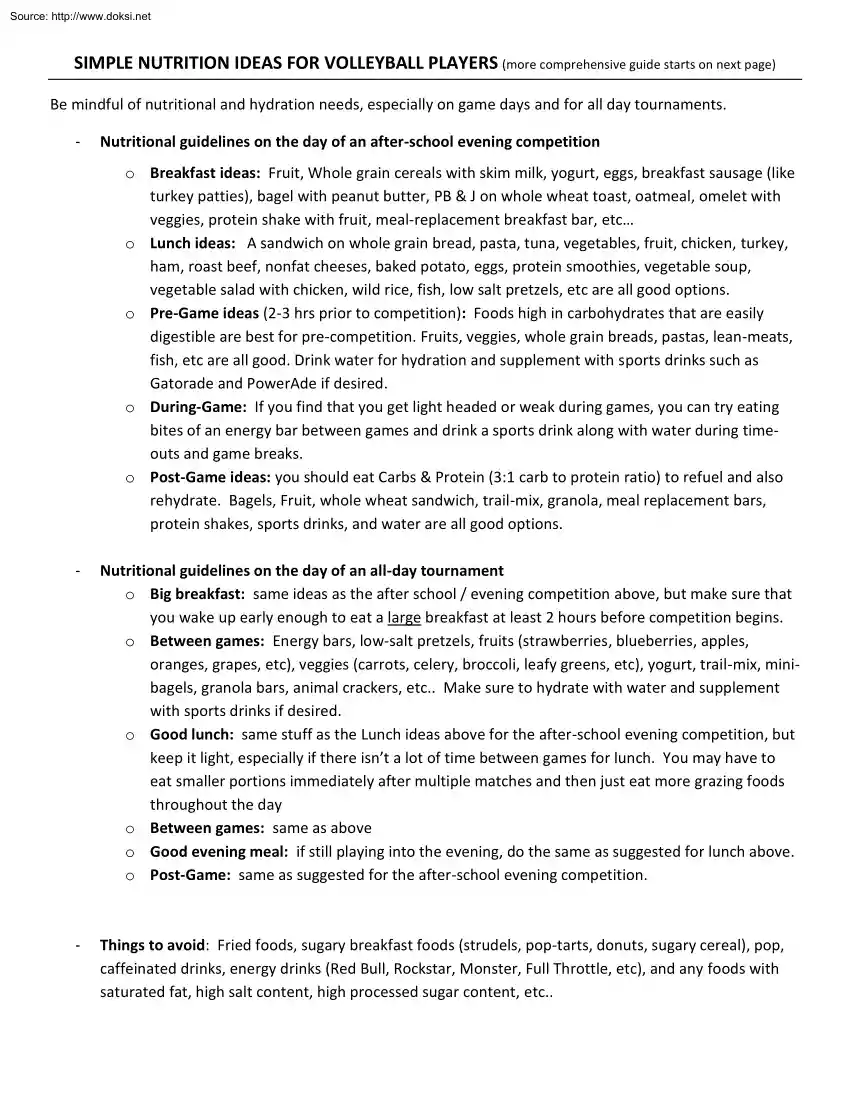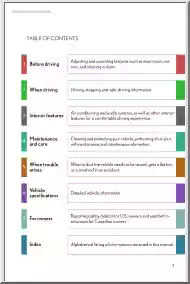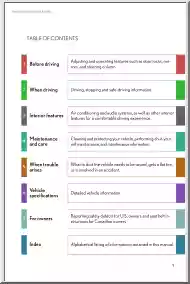Please log in to read this in our online viewer!

Please log in to read this in our online viewer!
No comments yet. You can be the first!
What did others read after this?
Content extract
Source: http://www.doksinet SIMPLE NUTRITION IDEAS FOR VOLLEYBALL PLAYERS (more comprehensive guide starts on next page) Be mindful of nutritional and hydration needs, especially on game days and for all day tournaments. - Nutritional guidelines on the day of an after-school evening competition o Breakfast ideas: Fruit, Whole grain cereals with skim milk, yogurt, eggs, breakfast sausage (like turkey patties), bagel with peanut butter, PB & J on whole wheat toast, oatmeal, omelet with veggies, protein shake with fruit, meal-replacement breakfast bar, etc o Lunch ideas: A sandwich on whole grain bread, pasta, tuna, vegetables, fruit, chicken, turkey, ham, roast beef, nonfat cheeses, baked potato, eggs, protein smoothies, vegetable soup, vegetable salad with chicken, wild rice, fish, low salt pretzels, etc are all good options. o Pre-Game ideas (2-3 hrs prior to competition): Foods high in carbohydrates that are easily digestible are best for pre-competition. Fruits, veggies, whole
grain breads, pastas, lean-meats, fish, etc are all good. Drink water for hydration and supplement with sports drinks such as Gatorade and PowerAde if desired. o During-Game: If you find that you get light headed or weak during games, you can try eating bites of an energy bar between games and drink a sports drink along with water during timeouts and game breaks. o Post-Game ideas: you should eat Carbs & Protein (3:1 carb to protein ratio) to refuel and also rehydrate. Bagels, Fruit, whole wheat sandwich, trail-mix, granola, meal replacement bars, protein shakes, sports drinks, and water are all good options. - Nutritional guidelines on the day of an all-day tournament o Big breakfast: same ideas as the after school / evening competition above, but make sure that you wake up early enough to eat a large breakfast at least 2 hours before competition begins. o Between games: Energy bars, low-salt pretzels, fruits (strawberries, blueberries, apples, oranges, grapes, etc), veggies
(carrots, celery, broccoli, leafy greens, etc), yogurt, trail-mix, minibagels, granola bars, animal crackers, etc. Make sure to hydrate with water and supplement with sports drinks if desired. o Good lunch: same stuff as the Lunch ideas above for the after-school evening competition, but keep it light, especially if there isn’t a lot of time between games for lunch. You may have to eat smaller portions immediately after multiple matches and then just eat more grazing foods throughout the day o Between games: same as above o Good evening meal: if still playing into the evening, do the same as suggested for lunch above. o Post-Game: same as suggested for the after-school evening competition. - Things to avoid: Fried foods, sugary breakfast foods (strudels, pop-tarts, donuts, sugary cereal), pop, caffeinated drinks, energy drinks (Red Bull, Rockstar, Monster, Full Throttle, etc), and any foods with saturated fat, high salt content, high processed sugar content, etc. Source:
http://www.doksinet Nutrition Guide – by Yvonne VanOort, KM Volleyball (Disclaimer: I’m not a nutritionist or a dietitian. This is simply a guide to being a strong and healthy athlete There is no black and white - everyone has different nutrition needs, and I only offered some basic examples.) Providing the right nutrition for your body enhances performance and prevents your body from breaking down during strenuous exercise. The more demand you physically put on your muscles, the more important it becomes to support them with the correct type of fuel. You will also have to add calories and drink plenty of water. To keep this document simple and easy to follow, let me break down the macro-nutrients (Fat, Protein, Carbohydrates) and how to obtain them easily and in a healthy way throughout your day. FATS: Monounsaturated fats and polyunsaturated fats are known as the “good fats” because they are good for your heart, your cholesterol, and your overall health. “GOOD” FATS:
(If you can, choose cold-pressed products, where the oil is not extracted under heat.) Monounsaturated fats - Olive oil Canola oil Sunflower oil Peanut oil Sesame oil Avocados Olives Nuts (almonds, peanuts, macadamia nuts, hazelnuts, pecans, cashews) Peanut butter Polyunsaturated fats - Soybean oil Corn oil Safflower oil Walnuts Sunflower, sesame, and pumpkin seeds Flaxseed Fatty fish (salmon, tuna, mackerel, herring, trout, sardines) Soymilk Tofu “BAD” FATS: Saturated fat - High-fat cuts of meat (beef, lamb, pork) Chicken with the skin Whole-fat dairy products (milk and cream) Butter Cheese Ice cream Lard Palm and coconut oil o (Processed or “partially hydrogenated” coconut oil is unhealthy, BUT you can use cold-pressed, virgin coconut oil) Trans fat - Commercially-baked pastries, cookies, doughnuts, muffins, cakes, pizza dough Packaged snack foods (crackers, microwave popcorn, chips) Stick margarine Vegetable shortening Fried foods (French fries, fried chicken,
chicken nuggets, breaded fish) Candybars Source: http://www.doksinet Saturated fats and trans fats are known as the “bad fats” because they increase your risk of disease and elevate cholesterol. Appearance-wise, saturated fats and trans fats tend to be solid at room temperature (think of butter or traditional stick margarine), while monounsaturated and polyunsaturated fats tend to be liquid (think of olive or corn oil). CARBS: carbohydrates (and fat) are your body’s source of energy. if exercising muscles do not have enough carbohydrates available to them, performance will decrease immediately consume carbohydrates post-exercise carbs are not your enemy choose good carbs, not NO carbs “GOOD” CARBS: - Fruit Vegetables Whole grains (oatmeal, steel-cut oats; cereal with whole wheat, whole oats, or other whole grain first on the ingredient list) Brown rice, wheat pasta, or if you can’t stand the whole wheat, try the ones with half white and half wheat
Beans are an excellent source of slowly digested carbohydrates as well as a great source of protein. Rule of thumb - stay away from things that come in boxes. The less processed the better for your body (that goes for all food, really). Also, try to limit any white, starchy carbs, like white flour, sugar, potatoes and white rice. Buy whole grain pasta, bread and wild rice Quinoa is a fantastic choice Eat lots of veggies For example, beans are slowly digested, meaning they keep your blood sugar level under control for a while and they are a great source of protein also. PROTEIN: your body is mostly made up of protein (next to water) it builds, repairs, maintains muscle tissue catabolic state: tearing down muscle tissue anabolic state: building phase “Good” PROTEIN: - chicken breast is best, (lean cuts of pork+beef) low-fat dairy (cheese, yogurt, milk, almond- or coconut milk) Quinoa lentils, beans, dried peas fish protein enriched pasta nuts and nut butters eggs
Eggs are good protein, but if you want to watch your cholesterol just have one yolk and the rest just egg whites. The yolk has all the vitamins, but it also contains all the fat and cholesterol These are just examples, but the list is not exclusive. Eat often and make wise choices. I’m not telling you to diet, but to put quality food into your body and have balanced meals. If you can, you should eat: breakfast morning snack lunch afternoon snack dinner evening snack Source: http://www.doksinet BREAKFAST: Never skip breakfast. It’s your most important meal of the day Eat within an hour of getting up Your body goes into starvation mode at night, and you don’t want to lose precious muscle. There is always time for breakfast. “I didn’t have time” is a bad excuse Set your alarm 10mins earlier to get a good start for your day Eating breakfast has been known to cause: Less body fat Improved learning/retention Improved mood Better food
choices later in the day Improved energy Muscle preservation Increased strength Good breakfast choices: - omelette with veggies - wheat toast with nut butter (for ex. almond or peanut) - Cottage cheese or greek yogurt and fruit - breakfast sausage (like turkey patties) - Protein shake (add some fruit and spinach to it for some extra vitamins) Bad breakfast choices: - Toaster strudel/ pop tarts (they are the worst choice of all choices in my book - YUCK!) - sugary cereal (cereal has very little nutritional value) - white bread (this includes bagels) - donuts - You get the point. PRE / POST WORKOUT: Before competition/practice/lifting: - Pick foods that are easily digested, so steak is probably not the best option here Carbs will fuel your energy level, fat and protein will keep you satiated. Again, a protein shake would be great After competition/practice/lifting: - You need to refuel and rehydrate so your body can recover Carbs will help you refill your glycogen storage
Protein (amino acids) will help you rebuild muscle that has been broken down during exercise Rehydrate - drink at least half the amount of your bodyweight in ounces In conclusion, the most important point that I want you to take away from this is that when training intensity goes up, you MUST have adequate nutrition, proper water intake and sufficient amount of sleep. The highest amount of growth hormones is released when you are asleep, and this works to restore your anabolic state, which is the opposite of a catabolic state. Get plenty of sleep, like 7-10 hours a night This wards off a catabolic state, sleep deprivation, elevated stress hormone levels and weakened immune system. Make healthy food choices to maintain a healthy body composition. “Good” carbs are not the enemy - they are an athlete’s friend. The enemy is poor food choices, meaning foods without any nutritional value Be aware of what you put into your body. The more natural the state of your food is the better For
example: fries vs potatoes or an apple vs. fruit snacks Source: http://www.doksinet Note to girls: If you train hard, eat properly, and lift heavy weights, you might gain weight (because you eat more nutritious food and gain muscle). This is a good thing We are not super-models on a Paris runway Muscle weighs more than fat, so if you step on the scale it might have gone up. Muscle tissue prevents you from getting injured, helps you to run faster, jump higher and ultimately makes for a healthier body composition. On the other hand, if you eat tons of junk food, the scale will also go up and if you have extra weight this will hinder you in being the athlete you want to be. Your joints and tendons will thank you for staying at a healthy weight. There’s no need to be at 6% body fat, but be mindful of how much processed food you eat Muscle definition looks and is healthy. This does not mean you’re turning into a bodybuilder or look like a dude (It takes a lot of effort to get to that
state and is highly unlikely, unless that is your goal and you consume a HUGE amount of calories.) Strong is the new skinny, and it is definitely healthy. “Without self-discipline, success is impossible, period.”
grain breads, pastas, lean-meats, fish, etc are all good. Drink water for hydration and supplement with sports drinks such as Gatorade and PowerAde if desired. o During-Game: If you find that you get light headed or weak during games, you can try eating bites of an energy bar between games and drink a sports drink along with water during timeouts and game breaks. o Post-Game ideas: you should eat Carbs & Protein (3:1 carb to protein ratio) to refuel and also rehydrate. Bagels, Fruit, whole wheat sandwich, trail-mix, granola, meal replacement bars, protein shakes, sports drinks, and water are all good options. - Nutritional guidelines on the day of an all-day tournament o Big breakfast: same ideas as the after school / evening competition above, but make sure that you wake up early enough to eat a large breakfast at least 2 hours before competition begins. o Between games: Energy bars, low-salt pretzels, fruits (strawberries, blueberries, apples, oranges, grapes, etc), veggies
(carrots, celery, broccoli, leafy greens, etc), yogurt, trail-mix, minibagels, granola bars, animal crackers, etc. Make sure to hydrate with water and supplement with sports drinks if desired. o Good lunch: same stuff as the Lunch ideas above for the after-school evening competition, but keep it light, especially if there isn’t a lot of time between games for lunch. You may have to eat smaller portions immediately after multiple matches and then just eat more grazing foods throughout the day o Between games: same as above o Good evening meal: if still playing into the evening, do the same as suggested for lunch above. o Post-Game: same as suggested for the after-school evening competition. - Things to avoid: Fried foods, sugary breakfast foods (strudels, pop-tarts, donuts, sugary cereal), pop, caffeinated drinks, energy drinks (Red Bull, Rockstar, Monster, Full Throttle, etc), and any foods with saturated fat, high salt content, high processed sugar content, etc. Source:
http://www.doksinet Nutrition Guide – by Yvonne VanOort, KM Volleyball (Disclaimer: I’m not a nutritionist or a dietitian. This is simply a guide to being a strong and healthy athlete There is no black and white - everyone has different nutrition needs, and I only offered some basic examples.) Providing the right nutrition for your body enhances performance and prevents your body from breaking down during strenuous exercise. The more demand you physically put on your muscles, the more important it becomes to support them with the correct type of fuel. You will also have to add calories and drink plenty of water. To keep this document simple and easy to follow, let me break down the macro-nutrients (Fat, Protein, Carbohydrates) and how to obtain them easily and in a healthy way throughout your day. FATS: Monounsaturated fats and polyunsaturated fats are known as the “good fats” because they are good for your heart, your cholesterol, and your overall health. “GOOD” FATS:
(If you can, choose cold-pressed products, where the oil is not extracted under heat.) Monounsaturated fats - Olive oil Canola oil Sunflower oil Peanut oil Sesame oil Avocados Olives Nuts (almonds, peanuts, macadamia nuts, hazelnuts, pecans, cashews) Peanut butter Polyunsaturated fats - Soybean oil Corn oil Safflower oil Walnuts Sunflower, sesame, and pumpkin seeds Flaxseed Fatty fish (salmon, tuna, mackerel, herring, trout, sardines) Soymilk Tofu “BAD” FATS: Saturated fat - High-fat cuts of meat (beef, lamb, pork) Chicken with the skin Whole-fat dairy products (milk and cream) Butter Cheese Ice cream Lard Palm and coconut oil o (Processed or “partially hydrogenated” coconut oil is unhealthy, BUT you can use cold-pressed, virgin coconut oil) Trans fat - Commercially-baked pastries, cookies, doughnuts, muffins, cakes, pizza dough Packaged snack foods (crackers, microwave popcorn, chips) Stick margarine Vegetable shortening Fried foods (French fries, fried chicken,
chicken nuggets, breaded fish) Candybars Source: http://www.doksinet Saturated fats and trans fats are known as the “bad fats” because they increase your risk of disease and elevate cholesterol. Appearance-wise, saturated fats and trans fats tend to be solid at room temperature (think of butter or traditional stick margarine), while monounsaturated and polyunsaturated fats tend to be liquid (think of olive or corn oil). CARBS: carbohydrates (and fat) are your body’s source of energy. if exercising muscles do not have enough carbohydrates available to them, performance will decrease immediately consume carbohydrates post-exercise carbs are not your enemy choose good carbs, not NO carbs “GOOD” CARBS: - Fruit Vegetables Whole grains (oatmeal, steel-cut oats; cereal with whole wheat, whole oats, or other whole grain first on the ingredient list) Brown rice, wheat pasta, or if you can’t stand the whole wheat, try the ones with half white and half wheat
Beans are an excellent source of slowly digested carbohydrates as well as a great source of protein. Rule of thumb - stay away from things that come in boxes. The less processed the better for your body (that goes for all food, really). Also, try to limit any white, starchy carbs, like white flour, sugar, potatoes and white rice. Buy whole grain pasta, bread and wild rice Quinoa is a fantastic choice Eat lots of veggies For example, beans are slowly digested, meaning they keep your blood sugar level under control for a while and they are a great source of protein also. PROTEIN: your body is mostly made up of protein (next to water) it builds, repairs, maintains muscle tissue catabolic state: tearing down muscle tissue anabolic state: building phase “Good” PROTEIN: - chicken breast is best, (lean cuts of pork+beef) low-fat dairy (cheese, yogurt, milk, almond- or coconut milk) Quinoa lentils, beans, dried peas fish protein enriched pasta nuts and nut butters eggs
Eggs are good protein, but if you want to watch your cholesterol just have one yolk and the rest just egg whites. The yolk has all the vitamins, but it also contains all the fat and cholesterol These are just examples, but the list is not exclusive. Eat often and make wise choices. I’m not telling you to diet, but to put quality food into your body and have balanced meals. If you can, you should eat: breakfast morning snack lunch afternoon snack dinner evening snack Source: http://www.doksinet BREAKFAST: Never skip breakfast. It’s your most important meal of the day Eat within an hour of getting up Your body goes into starvation mode at night, and you don’t want to lose precious muscle. There is always time for breakfast. “I didn’t have time” is a bad excuse Set your alarm 10mins earlier to get a good start for your day Eating breakfast has been known to cause: Less body fat Improved learning/retention Improved mood Better food
choices later in the day Improved energy Muscle preservation Increased strength Good breakfast choices: - omelette with veggies - wheat toast with nut butter (for ex. almond or peanut) - Cottage cheese or greek yogurt and fruit - breakfast sausage (like turkey patties) - Protein shake (add some fruit and spinach to it for some extra vitamins) Bad breakfast choices: - Toaster strudel/ pop tarts (they are the worst choice of all choices in my book - YUCK!) - sugary cereal (cereal has very little nutritional value) - white bread (this includes bagels) - donuts - You get the point. PRE / POST WORKOUT: Before competition/practice/lifting: - Pick foods that are easily digested, so steak is probably not the best option here Carbs will fuel your energy level, fat and protein will keep you satiated. Again, a protein shake would be great After competition/practice/lifting: - You need to refuel and rehydrate so your body can recover Carbs will help you refill your glycogen storage
Protein (amino acids) will help you rebuild muscle that has been broken down during exercise Rehydrate - drink at least half the amount of your bodyweight in ounces In conclusion, the most important point that I want you to take away from this is that when training intensity goes up, you MUST have adequate nutrition, proper water intake and sufficient amount of sleep. The highest amount of growth hormones is released when you are asleep, and this works to restore your anabolic state, which is the opposite of a catabolic state. Get plenty of sleep, like 7-10 hours a night This wards off a catabolic state, sleep deprivation, elevated stress hormone levels and weakened immune system. Make healthy food choices to maintain a healthy body composition. “Good” carbs are not the enemy - they are an athlete’s friend. The enemy is poor food choices, meaning foods without any nutritional value Be aware of what you put into your body. The more natural the state of your food is the better For
example: fries vs potatoes or an apple vs. fruit snacks Source: http://www.doksinet Note to girls: If you train hard, eat properly, and lift heavy weights, you might gain weight (because you eat more nutritious food and gain muscle). This is a good thing We are not super-models on a Paris runway Muscle weighs more than fat, so if you step on the scale it might have gone up. Muscle tissue prevents you from getting injured, helps you to run faster, jump higher and ultimately makes for a healthier body composition. On the other hand, if you eat tons of junk food, the scale will also go up and if you have extra weight this will hinder you in being the athlete you want to be. Your joints and tendons will thank you for staying at a healthy weight. There’s no need to be at 6% body fat, but be mindful of how much processed food you eat Muscle definition looks and is healthy. This does not mean you’re turning into a bodybuilder or look like a dude (It takes a lot of effort to get to that
state and is highly unlikely, unless that is your goal and you consume a HUGE amount of calories.) Strong is the new skinny, and it is definitely healthy. “Without self-discipline, success is impossible, period.”




 When reading, most of us just let a story wash over us, getting lost in the world of the book rather than paying attention to the individual elements of the plot or writing. However, in English class, our teachers ask us to look at the mechanics of the writing.
When reading, most of us just let a story wash over us, getting lost in the world of the book rather than paying attention to the individual elements of the plot or writing. However, in English class, our teachers ask us to look at the mechanics of the writing.